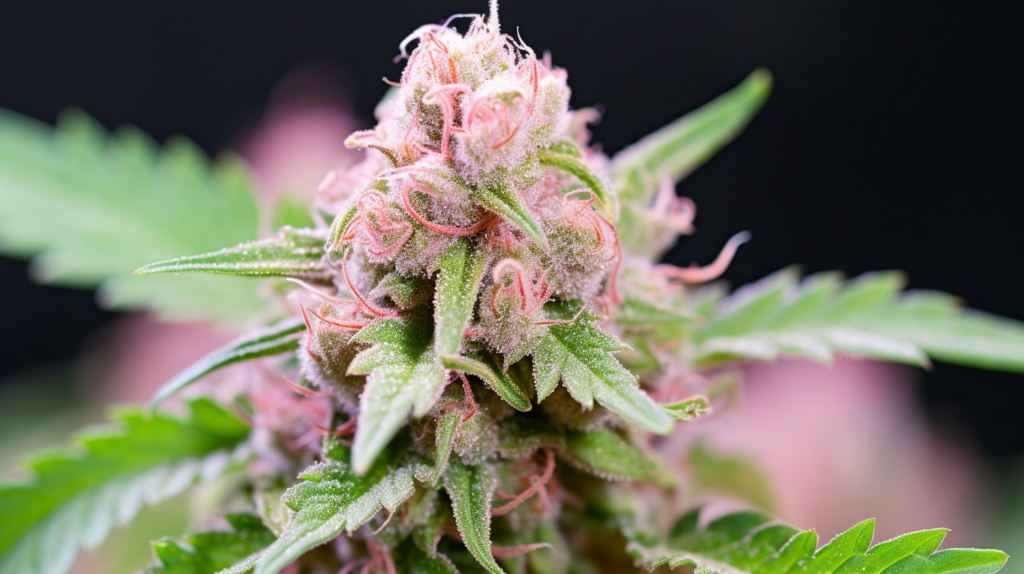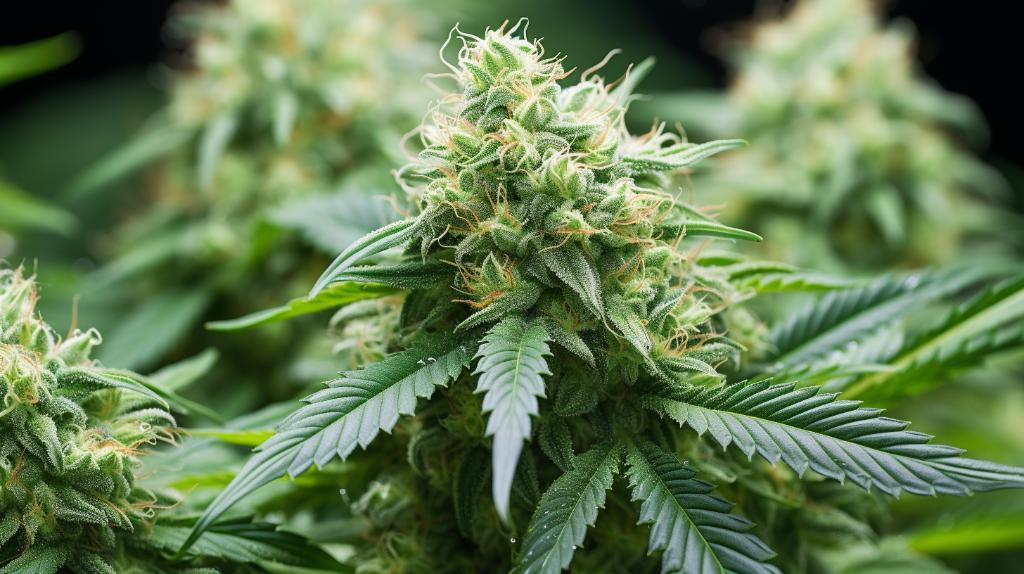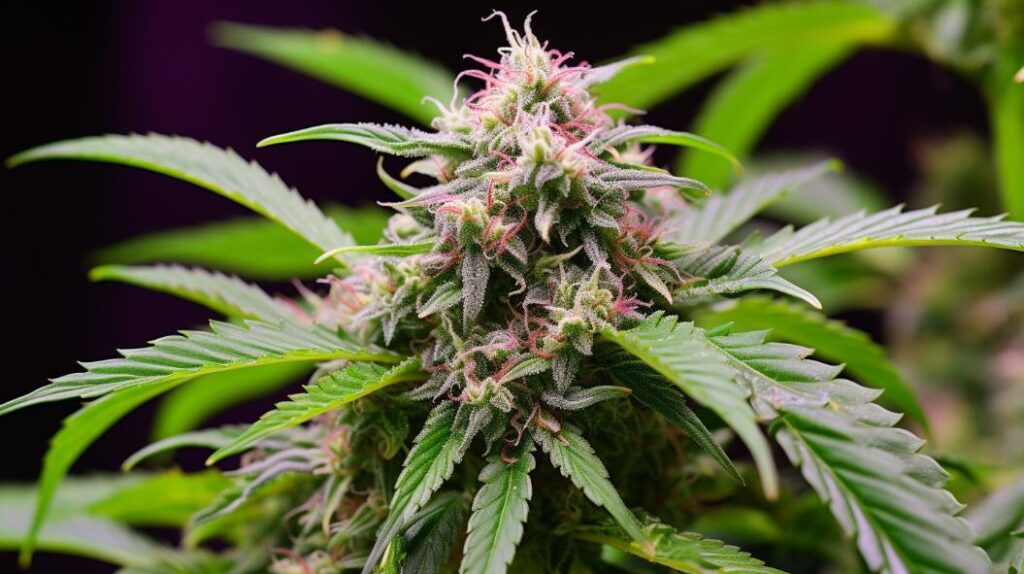Sweet Tooth

In the intricate tapestry of cannabis varieties, the Sweet Tooth strain has distinguished itself as a notable hybrid, intriguing both connoisseurs and novices with its award-winning lineage and balanced effects.
Characterized by its delectable flavor profile and a harmonious blend of Indica and Sativa genetics, Sweet Tooth has garnered attention not only for its palate-pleasing qualities but also for its therapeutic potential. With a moderate THC content that typically hovers around the 17% mark, this strain strikes a delicate equilibrium between recreational allure and medicinal efficacy.
As we examine the multifaceted nature of Sweet Tooth, from its genetic origins to its spectrum of effects and potential applications in the realm of medical cannabis, it becomes evident that it occupies a unique position in the pantheon of cannabis strains.
However, to truly appreciate the nuances of Sweet Tooth, it is essential to look beyond its surface qualities and explore the depths of its botanical complexity and the experiential anecdotes of those who have encountered its singular charm.
Genetic Lineage
The genetic lineage of the Sweet Tooth strain is a rich tapestry woven from the diverse strains of Afghani, Hawaiian, and Nepalese cannabis, offering a unique interplay of effects, flavors, and medicinal benefits. This crossbreed encapsulates the robust growth characteristics and potent resin production of its Afghani ancestor, while the incorporation of Hawaiian genetics introduces a cerebral uplift that complements the profound relaxation attributed to its Nepalese counterpart. Through the strategic crossing of Hawaiian and Nepali strains, Sweet Tooth emerges as a balanced hybrid, harmonizing the sedative qualities of its indica lineage with the energizing influence of sativa.
Expert understanding of Sweet Tooth’s genetic lineage elucidates the origins of its aromatic profile. The intermingling of sweet berry and floral notes can be traced back to the terpene compositions inherited from its parent strains. Moreover, the strain’s capacity to alleviate stress and manage anxiety is linked to the tranquilizing properties from its Afghani and Nepalese heritage, whereas the Hawaiian genetics may contribute to mood elevation and creativity, making it a versatile option for medical cannabis patients seeking comprehensive symptom relief.
THC/CBD Content
Sweet Tooth strain boasts a THC content typically ranging between 14% to 19%, with an average around 16%, and its CBD levels vary minimally, falling between 0% to 1.2%. The THC level in this strain makes it a moderately potent choice for recreational users and patients alike, providing a balance between psychoactive effects and therapeutic benefits without overwhelming potency.
The cannabinoid profile of Sweet Tooth is characterized by:
- A THC content that can reach up to 19%, appealing to those seeking a more intense experience.
- An average THC level of 16% that offers a balanced high, suitable for a broader audience.
- Lab data occasionally showing a lower THC content of 14%, which might be better for new consumers or those with lower tolerance.
- CBD levels that rarely exceed 1.2%, indicating that the strain’s therapeutic effects are predominantly driven by its THC component.
With its diverse range of THC levels, Sweet Tooth can cater to various preferences and tolerances. When analyzing the strain’s cannabinoid content, it’s clear that the THC level is the central aspect driving the strain’s popularity. The minimal presence of CBD suggests that users looking for substantial CBD benefits may need to look elsewhere.
Terpene Profile
Moving beyond cannabinoid content, the terpene profile of the Sweet Tooth strain plays a significant role in its sensory appeal and potential therapeutic effects. Terpenes are aromatic compounds that imbue cannabis with a rich tapestry of scents and flavors. In Sweet Tooth, these volatile molecules contribute to its characteristic sweet and fruity bouquet, which is not only pleasing to the palate but may also offer a range of health benefits.
The interplay of terpenes in Sweet Tooth can affect the overall user experience, modulating mood and influencing relaxation. Consumers seeking specific outcomes can use the terpene profile to guide their selection, as it provides clues to the strain’s effects beyond its THC and CBD content.
To better understand the terpene synergies at work, here is an insightful table highlighting the common terpenes found in cannabis and their properties:
| Terpene | Characteristics |
|---|---|
| Myrcene | Earthy, musky, and induces relaxation |
| Limonene | Citrusy, mood-enhancing, and stress-relieving |
| Pinene | Pine-like, alertness-promoting, and memory-aiding |
| Linalool | Floral, anxiety-reducing, and sedative effects |
Effects
Upon consumption, users of the Sweet Tooth strain often report a swift onset of happiness and euphoria, accompanied by an uplifted mood that characterizes the strain’s cerebral effects. These euphoric effects appear to be a defining feature, with many users seeking out Sweet Tooth for its potential to induce a pleasurable and carefree state of mind. An analytical look at the experiences shared by consumers reveals a pattern of benefits that extends beyond mere recreation.
The effects of Sweet Tooth can be itemized as follows:
-
Happiness and Euphoria: The strain is consistently associated with an immediate elevation of mood and a sense of well-being.
-
Relaxation: Alongside its cerebral impact, Sweet Tooth is also known for relaxing the body, often leading to a state of blissful lethargy.
-
Pain Relief: Many users report that this strain helps in managing pain, making it a popular choice for medicinal purposes.
-
Stress and Anxiety Reduction: The strain’s ability to alleviate stress and anxiety is frequently highlighted in user reviews.
Despite these positive attributes, it is essential to acknowledge the possibility of adverse effects, such as dry mouth, dry eyes, and in rarer cases, feelings of paranoia. Users are advised to consume Sweet Tooth responsibly and in moderation, especially those with a lower tolerance for THC or those who are prone to anxiety.
Medical Uses
How does the Sweet Tooth strain translate into medical benefits?
This particular cannabis variety has garnered attention for its palliative potential, particularly in relation to mental health concerns such as stress, anxiety, and depression. The strain’s calming properties offer substantial relief, soothing frayed nerves and providing a sense of tranquility to those besieged by such ailments.
Its efficacy is not limited to psychological conditions; Sweet Tooth also exhibits analgesic qualities that can alleviate both mild and chronic pains, proving advantageous for individuals grappling with insomnia and those experiencing a diminished appetite.
Patients have reported significant symptom relief, finding the strain instrumental in managing inflammation and enhancing their mood. Its potential sedative and anxiolytic effects make it a candidate for treating anxiety and panic disorders.
Furthermore, Sweet Tooth’s ability to induce sleepiness can be particularly beneficial for those with disrupted sleep patterns. Its capability to stimulate appetite is another valued medical use, as it can be helpful for those undergoing treatments that affect their desire to eat.
As such, Sweet Tooth stands out as a multi-faceted strain with a range of therapeutic applications, consolidating its position in the medical cannabis landscape.
Flavor and Aroma
Delving into the sensory qualities of the Sweet Tooth strain, one immediately encounters its delightful flavor profile, brimming with sweet, flowery, and berry notes that promise a genuinely pleasurable tasting experience. Connoisseurs appreciate its intricate symphony of tastes that are not only vivid upon the initial inhale but also leave a memorable impression long after the exhale.
The allure of Sweet Tooth is not limited to its taste; its aroma plays an equally compelling role in its popularity. Here’s a breakdown of its olfactory and gustatory characteristics:
-
Sweet Berry Essence: Users often detect a predominant burst of berry flavors, which provide a sugary, fruity backdrop akin to a natural berry medley.
-
Floral Bouquet: Accompanying the sweetness is a delicate floral presence, evoking the sensation of a blooming garden.
-
Earthy Undertones: A foundation of earthiness anchors the flavor, giving it a rich, grounding effect that contrasts the sweetness.
-
Citrus Finale: The presence of tangy, sweet grapefruit notes adds a refreshing zest that rounds out the experience, leaving a lasting citrusy finish.
Sweet Tooth’s flavor and aroma profile, marked by sweet and fruity undertones, solidifies its status as a strain that delivers a balanced and enjoyable high, making it a sought-after choice for both recreational and medicinal users alike.
Appearance
The Sweet Tooth strain presents visually striking buds characterized by a unique blend of rust and deep green hues, which are often dusted with a fine layer of trichomes that hint at its potency. This vivid appearance is not just aesthetically pleasing but also indicative of the strain’s rich cannabinoid profile. Each bud is a small testament to the strain’s genetic craftsmanship, offering an inviting glimpse into the pleasurable and long-lasting effects that await the consumer.
In an analytical overview of Sweet Tooth’s appearance, the strain’s long, deep green leaves cannot be overlooked. They seem to cradle the buds, augmenting the overall visual appeal with a contrast that underscores the rust-colored accents. The leaves are not just a backdrop; they are an integral part of the strain’s presentation, signaling the care taken in cultivation and handling.
The appearance of Sweet Tooth is a prelude to its sensory offerings. It complements the earthy, sweet, and flowery flavors that define its profile. The aesthetics of Sweet Tooth are a testament to its name, with the buds’ visual cues seamlessly connecting to the woody and flowery olfactory notes that were previously discussed under the ‘Flavor and Aroma’ subtopic. The strain’s visual allure is an integral part of its identity, inviting connoisseurs and newcomers alike to indulge in its delightful botanical symphony.
Grow Information
Building upon the visual appeal of Sweet Tooth, the cultivation of this cannabis strain is equally noteworthy, with its ability to thrive in both controlled indoor environments and the natural embrace of an outdoor setting. Considering its genetic lineage, Sweet Tooth brings forth a blend of robust traits inherited from Afghani, Hawaiian, and Nepalese strains, contributing to its versatility in growth environments and unique flavor profile.
For cultivators interested in maximizing the potential of Sweet Tooth, here are several key points to consider:
-
Growth Requirements: Sweet Tooth prefers a warm climate when cultivated outdoors, presenting a compact and bushy stature. It reaches maturity for harvest in October after a bloom period of 8-9 weeks.
-
Characteristics: This cannabis strain is renowned for its large, resin-coated buds that exude a sweet grapefruit aroma. These buds are not only visually appealing but also indicative of the strain’s high-quality genetic makeup.
-
THC Content: Lab data reveals that Sweet Tooth contains a THC percentage ranging between 14% and 19%, positioning it in the moderate to high potency category.
-
Consumer Information: Despite the lack of reviews, the strain’s potential effects and undiscovered qualities remain a topic of interest for both connoisseurs and new users alike.
In an analytical view, Sweet Tooth’s grow information suggests a strain that is accessible for both novice and experienced growers, with its moderate flowering time and adaptability to different growing conditions. The strain’s balanced THC content and enticing flavor profile make it a valuable addition to any cannabis enthusiast’s garden.
Adverse Effects
While Sweet Tooth is celebrated for its distinctive flavor and relaxing effects, users may experience several adverse reactions, such as dry mouth and eyes, which are the most frequently reported side effects. These conditions are not unique to Sweet Tooth but are rather common across various cannabis strains. Ensuring adequate hydration can help mitigate these discomforts. In addition, Sweet Tooth may induce feelings of paranoia, particularly in higher doses or among novice users. It is, therefore, prudent to start with a lower dosage and gradually increase as needed to avoid any overwhelming effects.
Operating heavy machinery or driving while under the influence of Sweet Tooth—or any cannabis product—is not advisable due to the potential impairment of cognitive and motor functions. Furthermore, individuals who are pregnant, breastfeeding, or have a predisposition to loss of appetite should approach Sweet Tooth with caution and ideally consult a healthcare professional before use.
Here is a quick reference table summarizing the potential adverse effects:
| Side Effect | Suggested Precaution |
|---|---|
| Dry mouth & eyes | Stay hydrated before and after consumption. |
| Paranoia | Begin with low dosages and adjust as needed. |
| Loss of appetite | Monitor dietary intake and consult a professional. |
Understanding these adverse effects is essential for informed and responsible use of the Sweet Tooth strain.
Comparisons with Similar Strains
Understanding the potential adverse effects of Sweet Tooth is crucial. It is also important to explore how it compares to other strains with similar genetic makeup and effects. Consumers seeking alternatives or comparisons to Sweet Tooth should consider the following:
-
Genetic Balance: Strains that mirror Sweet Tooth’s hybrid composition, blending both Sativa and Indica properties. A strain like Hawaiian, which also offers a balanced high, is a good example. It presents a pleasant euphoria without overwhelming sedation.
-
Euphoric Effects: Strains that elicit feelings of happiness and uplift similar to Sweet Tooth. These strains are typically characterized by their ability to promote a positive mood and increase sociability.
-
Flavor Profile: Sweet and flowery strains with berry notes that provide a comparable taste experience to Sweet Tooth. These flavors are often favored for their palatability and the way they complement the overall consumption experience.
-
Therapeutic Benefits: Strains that share Sweet Tooth’s reported medical advantages in combating stress, anxiety, and pain. These strains are valued for their potential to deliver relief while maintaining a functional state of mind.
Research and Studies
Numerous studies have highlighted the moderate potency of the Sweet Tooth strain, with a THC level typically around 16%, appealing to those who seek a balanced yet effective cannabis experience. This aligns with research and studies that categorize the Sweet Tooth as a 50/50 hybrid, offering the best of both Sativa and Indica properties. Its equilibrium of effects has been well-received, as evidenced by its victory in the prestigious High Times Cannabis Cup in 2001.
Research and studies also reveal its versatility in medical applications. Users report significant relief from stress, anxiety, depression, and various types of pain. This strain’s propensity for healing is matched by its sensory appeal; a unique flavor profile that combines sweet, flowery, and berry undertones has been documented, making it a delightful choice for cannabis connoisseurs.
| Aspect | Detail | Note from Research |
|---|---|---|
| Potency | Moderate (16% THC) | Suitable for a balanced experience |
| Genetic Composition | 50% Sativa / 50% Indica | Offers a balanced high |
| Medical Applications | Stress, anxiety, depression, pain relief | Reported benefits from users |
History and Origin
Building on its well-documented therapeutic benefits and sensory allure, the history and origin of the Sweet Tooth strain trace back to a blend of Afghani, Hawaiian, and Nepalese genetics, each contributing to its celebrated legacy in cannabis culture. This illustrious lineage has culminated in a strain that encapsulates the best attributes of its parentage, resulting in a harmonious balance between Sativa and Indica traits.
Here is a succinct overview of its genetic composition and accolades:
-
Genetic Lineage: Sweet Tooth is a cross between three distinct strains:
- Nepalese Indica, imparting a sweet, earthy aroma.
- Afghani Indica, offering a robust, resilient growth profile.
- Hawaiian Sativa, contributing to the strain’s uplifting and euphoric effects.
-
Balanced Hybrid: It boasts an even 50/50 split of Sativa and Indica genetics, making it a versatile choice for consumers seeking equilibrium in effects.
-
Award-Winning Pedigree: Sweet Tooth clinched the High Times Cannabis Cup in 2001, a testament to its exceptional quality and the prowess of its breeders.
-
Flavor Profile: The strain is renowned for its luscious, tangy, sweet grapefruit flavors—a sensory delight that complements its potent, cerebral high.
An analytical examination of Sweet Tooth reveals a strain that flawlessly merges the sensory and therapeutic aspects of its heritage, securing its status within the pantheon of esteemed cannabis varieties.
Frequently Asked Questions
Is Sweet Tooth Strain Indica or Sativa?
The inquiry pertains to the genetic heritage of a cannabis variety—whether it leans towards Indica or Sativa lineage. This particular strain exhibits a balanced hybrid profile, with an equal mix of both genetic influences.
Is Sweet Sweet Indica or Sativa?
Strain classification in cannabis is critical to understanding its potential effects. The term ‘sweet’ alone is insufficient to determine if a strain is Indica or Sativa without specific genetic background information.
What Are the Parents of Sweet Tooth Strain?
The genetic heritage of this particular hybrid encompasses a blend of Nepalese Indica, Afghani Indica, and Hawaiian Sativa, which collectively impart its distinctive effects and flavor profile.
What Are the Effects of Sweet Treat Strain?
The Sweet Treat strain typically elicits effects such as euphoria and an uplifted mood, which may alleviate stress and anxiety. However, users should be cautious of side effects like dry mouth and paranoia.







Responses